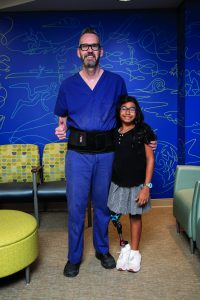 By Leigh-Ellen Romm
By Leigh-Ellen Romm
What’s the difference between a good life and a meaningful one? Dr. Mark Hébert, Professor of Philosophy and Co-Director of the Philosophy, Political Science and Economics program, refers to Dan McAdams, the modern philosopher who suggests a person can discern their calling by figuring out their strengths and gifts, then organizing a life that draws on those things for work and family.
“Knowing what you care about and what you do well can lead to a good life,” says Hébert, “But, using your talents and gifts in the service of something greater leads to a meaningful life. The really interesting thing is,” he continued, “the most meaningful and engaged life is one that is not focused on yourself. A person allows the values they think are most important about themselves to be expressed in the service of someone else.”
Meet these Austin College alumni: a minister, an athlete, a sculptor, and a dentist, who sorted through the many possibilities for work and avocation, and after a time have found deeply meaningful work and service using the tenets of an Austin College education and their own gifts and skills.
 Gary Ivory ’89 has the top job at Youth Advocate Program (YAP), Inc., but his inspiration comes from his childhood on a farm in East Texas and a never-give-up determination to help others.
Gary Ivory ’89 has the top job at Youth Advocate Program (YAP), Inc., but his inspiration comes from his childhood on a farm in East Texas and a never-give-up determination to help others.
As president and interim CEO, Ivory oversees the community-based programming dedicated to helping young people and their families avoid unnecessary out-of-home placements in foster care, group homes, youth prisons, or detention centers. He leads 2,100 staff members in the $85 million operation in 34 states and Washington D.C., along with global offices in Africa, Europe, Ireland, Australia, and Guatemala.
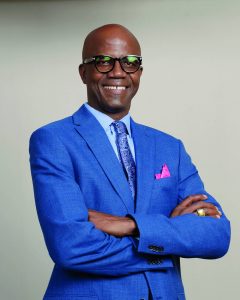 “We want to strengthen families and keep young people safely at home,” Ivory says. “We believe that when young people are safely supported in their homes and in their communities, they are more likely to reach their full potential as healthy, wellrounded, and engaged members of our society.”
“We want to strengthen families and keep young people safely at home,” Ivory says. “We believe that when young people are safely supported in their homes and in their communities, they are more likely to reach their full potential as healthy, wellrounded, and engaged members of our society.”
Since 1975, the YAP Wraparound Model envelops the participants in grace and works with them to plan for their own success, then provides paid, trained Advocates and behavioral health staff who help work the plan.
“We talk at YAP that when you experience trauma, when you have seen and witnessed a lot, then those things have an impact on your future,” Ivory said. Gary’s own family experienced poverty and three of his brothers were incarcerated. He’s familiar with a childhood that included exposure to traumatic events.
“Looking back, I realize I did see a lot of things that a lot of people do not see,” he said. “I think having people at Austin College who listened to me, encouraged me and had an interest in not only my academics but also my career path—I think it’s why I wanted to continue to do this kind of work.” Among the faculty and staff who provided a nurturing environment for Gary as a student were Chaplain Henry Bucher and the late Robert Mason,
basketball coach.
“I appreciate every day at Austin College,” he said. “The relationship with them was so important. They’re the ones who helped to guide me through a process, and they prepared me to go to seminary. All that prepared me to answer my ‘why’ to do what I’m doing now.”
 Ivory was ordained as a Christian minister at 17 years old, and after graduating from Austin College with majors in English and Business, he completed a Master of Divinity degree in Ethics at Princeton Theological Seminary in New Jersey. He says, “Austin College was a great place to explore my faith. The calling God gave me was a sense of wanting to help others who had been hurting in some way. I always say we are serving the least, last, lonely, and unloved. That’s what this is all about.”
Ivory was ordained as a Christian minister at 17 years old, and after graduating from Austin College with majors in English and Business, he completed a Master of Divinity degree in Ethics at Princeton Theological Seminary in New Jersey. He says, “Austin College was a great place to explore my faith. The calling God gave me was a sense of wanting to help others who had been hurting in some way. I always say we are serving the least, last, lonely, and unloved. That’s what this is all about.”
In his 30-year career, Gary has met and worked with thousands of youths and their families. He readily recalls Dante, who in early 1993 survived a gang shooting in Dallas, when others did not. “I preached three funerals in one week,” Ivory says. “Dante’s mom had addiction issues; he identified with a gang. He was so angry—the angriest kid I’d ever seen. We helped his mom deal with her drug problem in rehab while we worked with him on his anger. He was assigned a paid mentor who met with him several hours a week. You see, Dante was a leader, but you couldn’t see that because of all the things at home that were masking that in him.”
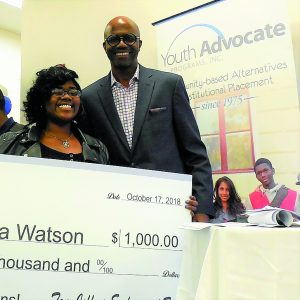 YAP helps bring out the best in people and supports many through scholarships for education and vocational training. The Tom Jeffers Endowment Fund for Continuing Education, named after the YAP founder, has raised more than $2 million and supplied financial support to more than 300 current or past program participants.
YAP helps bring out the best in people and supports many through scholarships for education and vocational training. The Tom Jeffers Endowment Fund for Continuing Education, named after the YAP founder, has raised more than $2 million and supplied financial support to more than 300 current or past program participants.
“We never give up,” Ivory says. “Dante did well—I still hear from him. He got off probation. He did AmeriCorps. He’s not incarcerated. To me that’s a success. We extend ‘untraditional charity’ that never gives up on people: even when they make mistakes, even when they have a relapse, even when they go back to a relationship that was bad for them, even when they have a law violation. We still don’t give up.”
“We say, ‘You are a person who is worthy of support and intervention,’” he says. “That is what gives me hope.”
For more information about the work done at YAP, go to https://www.yapinc.org.
 When Kaitlin Elledge ’11 talks about Beads of Courage, her emotions well up. As a triathlete, she recalls the power of two beads pinned over her heart to move her focus from herself to others.
When Kaitlin Elledge ’11 talks about Beads of Courage, her emotions well up. As a triathlete, she recalls the power of two beads pinned over her heart to move her focus from herself to others.
Beads of Courage is a nonprofit organization that serves 60,000 seriously ill children worldwide with beads that commemorate each step of their medical journey. In 2005, Jean Gribbon, R.N., Ph.D., founded the arts-in-medicine program in Tuscon, Arizona to support children, their families, and clinical caregivers by giving them a meaningful way to tell their stories and commemorate their courage. With 400 partner hospitals worldwide, Beads of Courage delivers more than 14 million beads each year.
 Anyone can build a strand of beads by participating in the Carry a Bead program like Kaitlin did in her first Iron Man race. She chose Iron Man as a way to continue her athletic endeavors after playing years of college soccer. It would be challenging, and she could compete alongside her triathlete father who encouraged her. On the eve of the race, a friend told her about Carry a Bead and invited her to take part. Saying yes was the starting gun for a long commitment to a worthy cause.
Anyone can build a strand of beads by participating in the Carry a Bead program like Kaitlin did in her first Iron Man race. She chose Iron Man as a way to continue her athletic endeavors after playing years of college soccer. It would be challenging, and she could compete alongside her triathlete father who encouraged her. On the eve of the race, a friend told her about Carry a Bead and invited her to take part. Saying yes was the starting gun for a long commitment to a worthy cause.
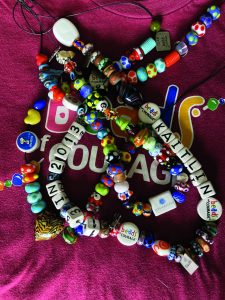 Carry a Bead invites anyone: athletes, birdwatchers, astronauts, Olympians, singers, Nascar drivers, anyone to carry a matching set of beads with them at any sort of event. The idea is that the beads go on an adventure, then the carrier sends one back with the story of the event and keeps one for their own strand. The returned bead and the handwritten note will ultimately go to a child in the program to give them courage.
Carry a Bead invites anyone: athletes, birdwatchers, astronauts, Olympians, singers, Nascar drivers, anyone to carry a matching set of beads with them at any sort of event. The idea is that the beads go on an adventure, then the carrier sends one back with the story of the event and keeps one for their own strand. The returned bead and the handwritten note will ultimately go to a child in the program to give them courage.
“I pinned this matching set of beads over my heart on my tri-suit,” Kaitlin says. “It changed the way I thought about racing. There’s a dark time in each event within a triathlon when I think, ‘This is really tough, and I don’t know why I’m doing this. I have lost my mind.’ But suddenly the beads change my perspective.”
Kaitlin continued, “I was fortunate enough to train and race, and I felt like it was my responsibility to get those beads across the finish line, because what I was going through was not like anything the kids are going through in our program. I was not undergoing cancer treatment, or I had not recently had a heart transplant. The program brings so much perspective to the athletes who are carrying those
beads—and it just got me through. After that I carried beads in everything I did—every race, every vacation, all of it. So, I’ve built a strand of beads knowing all of those have a sister bead with a child somewhere.”
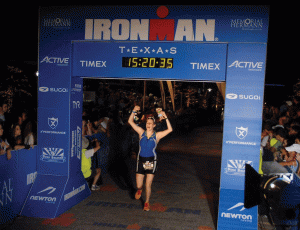 Since that race in 2012, Kaitlin met and worked with Jean Gribbon and completed a marketing program for Beads of Courage as a capstone project for her Master of Business Administration degree from The University of Texas at Austin. She and her project team designed a Carry a Bead program specifically for heroes and first responders by creating the collateral, kits, and marketing for the program. Soon after, Jean invited her to be on the board of directors, where she brings her unique skill set as a business-minded athlete who loves the arts to help strategically grow the program around the world.
Since that race in 2012, Kaitlin met and worked with Jean Gribbon and completed a marketing program for Beads of Courage as a capstone project for her Master of Business Administration degree from The University of Texas at Austin. She and her project team designed a Carry a Bead program specifically for heroes and first responders by creating the collateral, kits, and marketing for the program. Soon after, Jean invited her to be on the board of directors, where she brings her unique skill set as a business-minded athlete who loves the arts to help strategically grow the program around the world.
She says that her time at Austin College, where she majored in Spanish and Business Administration, played women’s soccer, and spent many hours working with technical aspects of theatre, prepared her for her profession in business and her nonprofit service.
“I think the ability to do a lot of different things at one time at Austin College helped prepare me tactically to manage a lot of different things that I want to do. Beads of Courage lets me be involved in the business side by helping plan strategy for the growth of the organization. I can also immediately participate as an athlete, and then Beads of Courage is one of few arts-in-medicine treatment programs that is not raising money for a future disease—we’re working on making the patient better today.”
Kaitlin, who has met many Bead Families over the years, says, “When you talk to a child who has received beads and they can tell you what every bead on their strand means and what their favorite one means, when they got it, and why they got it — it’s heartbreaking, but it’s also impactful and inspiring. It changes the perspective for the child from ‘I got poked with a needle 45 times in the last month to ‘Oh my gosh, look at all these beads I got!’”
If you would like to learn more about Beads of Courage, go to www.beadsofcourage.org.
 Sometimes it’s the “dry spell” in a career that births the best ideas … just ask an artist.
Sometimes it’s the “dry spell” in a career that births the best ideas … just ask an artist.
Dwight Putnam ’93 is a former pre-med student turned art major who worked as a commercial sculptor and is now a highly skilled pediatric prosthetist. He is well acquainted with the grit necessary to change a plan.
Dwight says he lasted 15 minutes in Austin College pre-med organic chemistry class when he realized he needed a new major and a new career. He chose art and soon met fellow artist Johnny Edwards ’93, who not only was a good friend and talented sculptor but also played a key role in Dwight’s early career as a commercial fabricator.
 “While I had great ideas, it would actually take many years before my hand skills caught up,” Dwight says. “Mark Monroe (Associate Professor of Art) encouraged me, saying, ‘As long as you continue to make art, your hands will eventually catch up with your mind.’ He was right.”
“While I had great ideas, it would actually take many years before my hand skills caught up,” Dwight says. “Mark Monroe (Associate Professor of Art) encouraged me, saying, ‘As long as you continue to make art, your hands will eventually catch up with your mind.’ He was right.”
In the early years after graduation from Austin College, Dwight worked with Johnny as a threedimensional environmental fabricator using his artist skills.
“Life as an artist, while exciting for sure, lacked a certain since of stability,” he says. “During one of my ‘dry periods,’ my mother suggested I look into an ad in the paper for artists to fabricate realistic silicone prostheses.” With his portfolio, he was hired as a technician sculpting wax hands, feet, fingers, ears, and noses. These sculptures would be molded and turned into realistic prostheses.
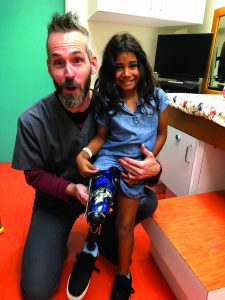 Prosthetists become licensed and certified with post-grad education and can expect greater opportunities and more stable careers. After more than 10 years since graduating from Austin College, Dwight completed the graduate program at California State University in Dominguez and a residency at Texas Scottish Rite Hospital for Children (TSRH).
Prosthetists become licensed and certified with post-grad education and can expect greater opportunities and more stable careers. After more than 10 years since graduating from Austin College, Dwight completed the graduate program at California State University in Dominguez and a residency at Texas Scottish Rite Hospital for Children (TSRH).
“Armed with my portfolio, 10 years of experience as a commercial fabricator and three years as a technician, I set up my interview and TSRH hired me,” he said. “My residency went so well that the hospital created a permanent position for me. The rest, as they say, is history. I hit the ground running and never looked back. That was 15 years ago this last spring.”
Scottish Rite in Dallas, Texas, is a world-renowned specialty hospital focused on pediatric orthopedic conditions. Dwight reports that his department makes roughly 350 to 375 customized prosthetic limbs each year for children who are 9 months to 18 years old. They come from all walks of life, from just about every country around the world.
“The large majority of the upper-extremity devices I make are highly customized tools that allow the patient to participate in whatever activities they have their heart set on,” he said. “I have made upper-extremity devices for playing a variety of musical instruments, riding bikes, cheerleading, gymnastics, football, baseball, horseback riding, fishing, and even for showing livestock at auctions.”
“Being able to elevate my patients’ quality of life has been life-changing for both me and my patients. Over time you become an extended part of their families,” he said. “I am basically a professional uncle to several hundred nieces and nephews from around the globe.”
Technology, such as 3D printing and CADCAM technology, has helped expand the number and types of pediatric prosthetic components that are available. Many were once available only for adults but have been miniaturized and redesigned for smaller amputees.
“We just got our first 3D printer and are waiting on a state-of-the-art 6-axis CADCAM carver to be installed in our department,” Dwight says. “This particular brand of carver is only the second one of its type in the world. Now the challenge is getting trained in this technology and figuring out how to apply these amazing machines into our daily practice.”
Not one to back down from change or challenge, Dwight will likely draw on the grit he sees in his young clients to apply the technology to help them realize their dreams.
“This population of amputees is incredibly resilient and very energetic,” he said. “They do not view themselves as being any different than their peers or siblings. This unique perspective drives them to pursue the same activities as their friends and peers. This in turn inspires me to create the best device I can for each patient.”
To learn more about Scottish Rite go to www.scottishriteforchildren.org.
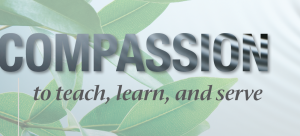 Initially, Lieutenant Commander Alice-Anne Alcorn, DDS, MSD, chose dentistry over general medicine so she could help others and have a predictable schedule, few emergencies, and maybe Fridays off—but then she decided she’d like to see the world.
Initially, Lieutenant Commander Alice-Anne Alcorn, DDS, MSD, chose dentistry over general medicine so she could help others and have a predictable schedule, few emergencies, and maybe Fridays off—but then she decided she’d like to see the world.
After completing her bachelor’s degree in business administration at Austin College, she joined the Navy and attended Baylor School of Dentistry on a U.S. Military Health Professional Scholarship Program. Taking her family with her, she has served near Hiroshima, lived in Honolulu, Indiana, and Camp Pendleton in California. In mid-summer 2021, she was selected to deploy as the Dental Planner with the Pacific Partnership 2022 aboard the USNS Mercy (T-AH 19).
 Named for the virtue of compassion, the USNS Mercy (T-AH 19) brings people of different nations together, building relationships as they prepare to work together in the event of a natural disaster or emergency. Participating nations in the 2022 deployment included United States, Australia, Japan, United Kingdom, Taiwan, Oregon National Guard, Republic of Korea, and Chile.
Named for the virtue of compassion, the USNS Mercy (T-AH 19) brings people of different nations together, building relationships as they prepare to work together in the event of a natural disaster or emergency. Participating nations in the 2022 deployment included United States, Australia, Japan, United Kingdom, Taiwan, Oregon National Guard, Republic of Korea, and Chile.
The USNS Mercy (T-AH 19) was converted from oil tanker to hospital ship in the mid-80s. It’s the largest hospital ship in the world and one of the largest trauma facilities in the United States. When fully staffed, there are up to 1200 medical professionals and 70 crew members aboard the ship.
Alice-Anne’s duties as Dental Planner began months before the trip was scheduled to embark in January 2022. After many hurdles, including COVID restrictions and proverbial red tape at home and abroad, the ship and crew finally set out in May 2022.
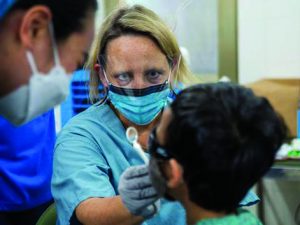 She says the Austin College experience helped her navigate the changes in plans and press on toward the goal. “That (Austin College) made such a lasting impression and foundation,” she said. “Classes like Heritage (Heritage of Western Civilization) made you get out of your comfort zone and look at the world in a different way. I realized there’s not always just one way to do something. You can pivot, be flexible, and adapt to the new challenges.”
She says the Austin College experience helped her navigate the changes in plans and press on toward the goal. “That (Austin College) made such a lasting impression and foundation,” she said. “Classes like Heritage (Heritage of Western Civilization) made you get out of your comfort zone and look at the world in a different way. I realized there’s not always just one way to do something. You can pivot, be flexible, and adapt to the new challenges.”
In the military, this is called “Semper Gumby,” and it’s a helpful skill for big missions like this.
“The purpose of these Pacific Partnerships is to build relationships with our ally nations so if a disaster occurs … we’ve got the lay of the land and we’ll know what resources may be readily available or not,” she said. The Pacific Partnership deploys annually into the Indo-Pacific Region, although the destinations may vary. On this tour, host nations included Vietnam, the Philippines, Palau, and Solomon Islands.
Alice-Anne arrived in the Solomon Islands two full months ahead of the ship to scout out facilities, assess dental and medical supplies and needs, and begin scheduling engagements with the Solomon Islanders. She says she felt like she became an Islander for that time.
“I saw how little they have and how difficult it is to just get around on small buses,” she said. “They walk five miles to get anywhere. Some would have to take a banana boat, but it could cost a year’s salary.”
 Working alongside the medical professionals at the various locations, the dentists and hygienists saw 3,713 dental patients. Doctors, surgeons, optometrists and even veterinarians completed thousands of engagements to care for the people and their animals—all the while, teaching and learning from one another.
Working alongside the medical professionals at the various locations, the dentists and hygienists saw 3,713 dental patients. Doctors, surgeons, optometrists and even veterinarians completed thousands of engagements to care for the people and their animals—all the while, teaching and learning from one another.
Alice-Anne’s Austin College opportunities such as JanTerm in Spain, Model UN, Posey Leadership Institute, and even Heritage class gave her a picture of how the diplomatic process works and how to understand the goals and needs of the host country.
“We are always learning and paying it forward. It doesn’t matter where you’re from or what you speak,” she said. “We had translators; but when you’re doing dentistry, you don’t always have to talk.”
The Pacific Partnership 2022 included engineering projects to build schools, renovate playgrounds and improve facilities. Community engagement opportunities included beach cleanups and tree planting, reading at schools, band concerts, and sports events like soccer and basketball with the locals.
As a Navy dentist, Alice-Anne has enjoyed a group-practice environment, served her country, and had the benefit of traveling the world. And, on the USNS Mercy, she said “yes” to her original why—to help others, while completely setting aside all options for a predictable schedule.
To read more, view Pacific Partnership.


